|
Republic
Aviation Corporation in World War Two
Indiana Division
Evansville, IN
1942-1945
This page updated 9-20-2022.
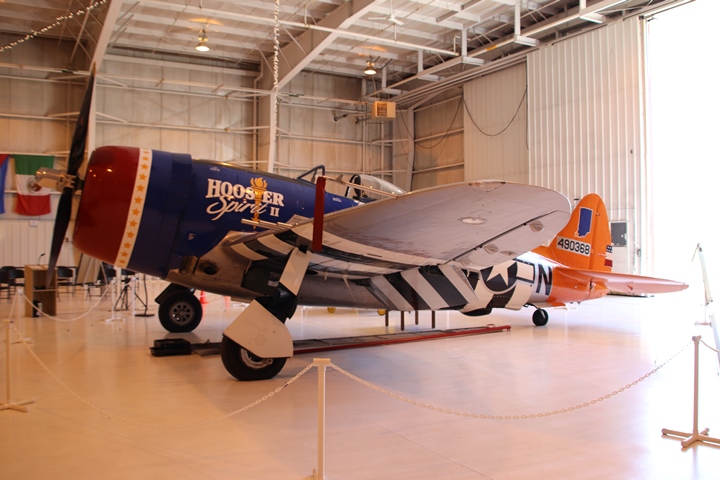
Back home again in Indiana. It is
for this P-47D Thunderbolt Army Air Force Serial Number 44-90368 that
was built in Evansville, IN in May 1945. It is now owned by the
Evansville P-47 Foundation, Inc. and currently the centerpiece
attraction at the Evansville Wartime Museum at the Evansville, IN
airport. Now named "Hoosier Spirit II," it is located a mile north of
where it was built at the former Republic Aviation Corporation, Indiana
Division plant.
Delivered to the Army Air Force on May 7,
1945, it first served at Independence Field, MO where it was
re-designated as a TP-47D. It then served at Kelly Field in San
Antonio, TX and then was part of the America's Republic Project as part of
the Caribbean Command. On October 28, 1947, it became part of
the Venezuelan Air Force, serving there until 1971 when it was purchased by
a private owner and returned to the United States. It then was
purchased by a French owner in 1975 and was placed into storage where it
remained until 1987. Charles Osborne of Louisville, KY purchased
it and returned it home again for the first time, as Mr. Osborne kept
his collection of warbirds at the Sellersburg, IN airport. It took
four years to restore the aircraft to flying condition; and in 1991 it
made its first flight as N4747P. In July 1998 it was sold to the
Lone Star Museum of Galveston, TX which later moved to Houston, TX.
On Thursday, October 15, 2020, P-47D 44-90368 landed at the Evansville,
IN airport after the Evansville P-47 Foundation purchased it from the Lone Star
Museum for $3.5 million.
The ferry flight of P-47D 44-90368 may well
have been its first flight. On my first visit to the Evansville
Wartime Museum in 2021, a conversation with a docent indicated that the
Evansville P-47 Foundation was interested in keeping the aircraft
airworthy. However, the docent also noted that most likely the
aircraft would remain a static display at the museum. In order to
keep it airworthy, the Foundation would need to find funding each year
to perform the annual inspection of the aircraft. This would either entail the aircraft
being removed to another hangar for the inspection or the inspection
being done in the museum.
After spending $3.5 million to bring P-47D
44-90368 back home again, it seems unlikely the Foundation is going to
risk damaging the aircraft in flight operations. Most likely this
P-47 has flown for the last time.
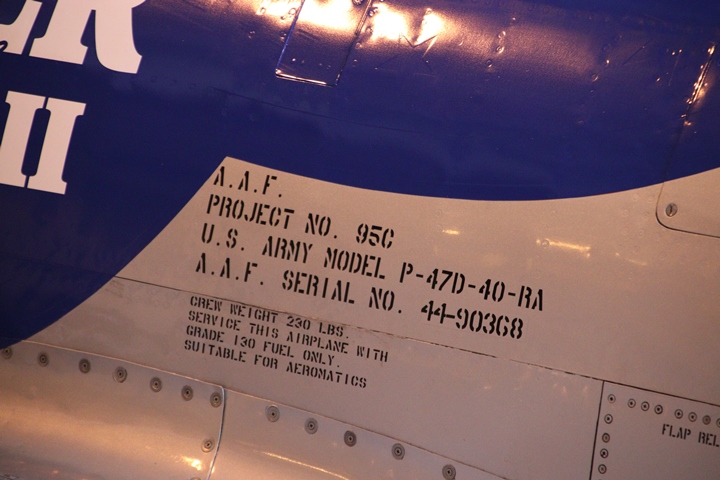
Author's photo.
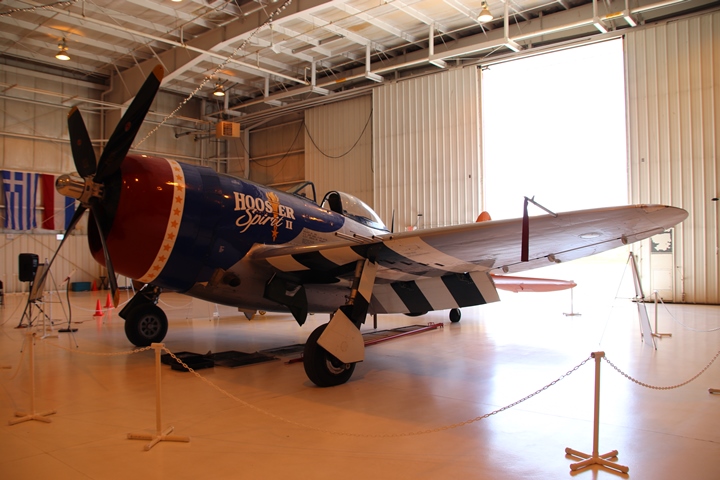
Author's photo.

Author's photo.
They told the kid, a '38s the thing
It's got two props and guns that sing.
It's got plenty of range, and can carry a load
And its a friend to have on a combat road.
But the kid looked up and said in revolt,
"You take your '38, I'll take a Thunderbolt."
Then they said, "The Spits mighty sweet
And for maneuverability it can't be beat.
It met the Luftwaffe at its best
And records show it passed the test."
But the kid just answered, with a smile and a shrug
"You take the Spit, I'll take a 'Jug'."
Then they said, "Those two are pretty hot,
But they don't have what the '51's got.
It's got the guns and it's got the speed
And more damned gadgets than you'll ever need."
The kid looked up and shook his head
"Keep them both, Mine's a jug instead."
The kid spoke, "Your '38s sweet,
Your Spits pretty hot, and the 51's neat,
But, listen fellows, I'll make a bet
Just fly those ships, they'll kill you yet
And when you're up in "Pilot Heaven"
I'll still be here in a P-4-7."
Unknown Author
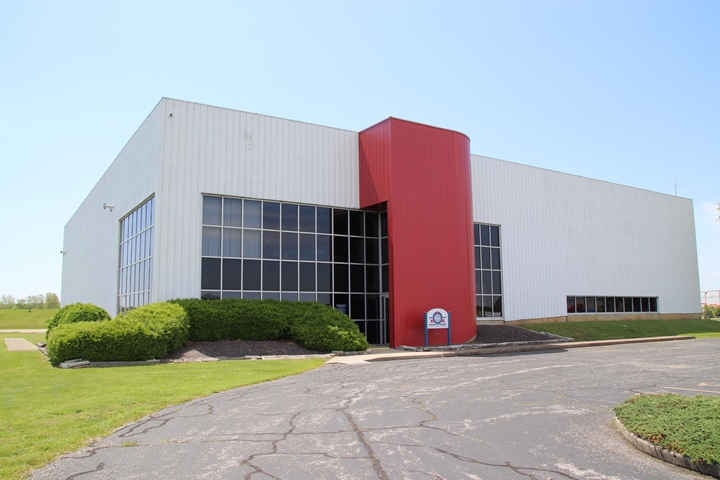
On October 22, 2020, P-47D 44-90368 was put on
display in the Evansville Wartime Museum. Placing the aircraft on
display was the end of a twenty year endeavor to bring an Evansville-built
P-47 back home. Author's photo.

While 44-90368 was part of the Lone Star
Museum, it was known as "Tarheel Hal." Here it is taxiing out to
fly in the 2009 Houston Air Show. Author's photo.
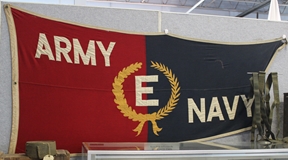
The Republic Aviation Corporation's Indiana
Division won the Army-Navy "E" flag three times during World War Two.
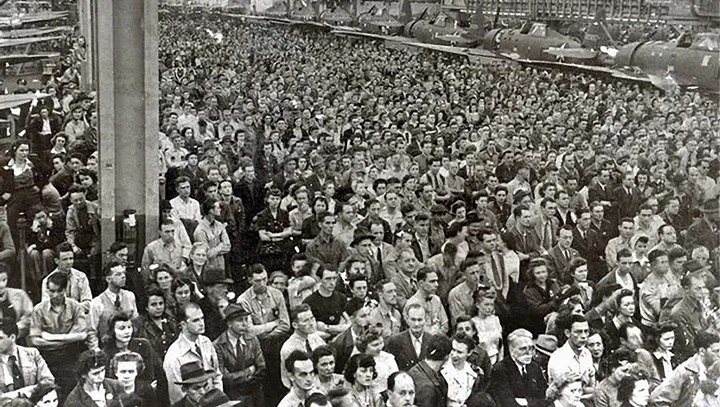
Employees of the Evansville P-47 plant
stopped working in order to listen to the proceedings for the winning of
the first Army-Navy "E" award. This was May 22, 1944.
Republic Aviation Corporation's Indiana
Division World War Two Products: The P-47s that came off the
Republic Evansville, IN production lines were used in all theaters of
operation during World War Two. They were the workhorse fighters
of the United States Air Force from 1942 through 1945. In 1943 and
early 1944, the Thunderbolts were used extensively as escort aircraft for the
B-17s and B-24s in their bombing missions into Europe. The top two
aces in the
European Theater flew P-47s. When the more
advanced and higher performing P-51 began arriving in that theater later
in World War Two and had more kills of enemy aircraft than the P-47,
more than one P-47 pilot remarked that the P-47s had already shot down
the best of the German pilots and done all of the hard work.
The P-47 was a tough aircraft. The ten
top P-47 aces of World War Two all survived the war. This cannot
be said for the top ten aces of the P-38 and P-51.
After the arrival of the P-51, the P-47 became
famous as a low level bomber. It was the most heavily armed
American fighter of World War Two with eight .50 caliber machine guns.
While many of the P-47s were lost to combat and accidents in the early
stages of the war, two-thirds of them still existed when hostilities
ceased.
In December 1944 it was announced that the
Evansville plant would begin the production of the P-47N and B-29 engine
cowls in early 1945. However, delays in the B-29 engine cowl
program delayed the proposed production until September 1, 1945, two
weeks after the end of World War Two. As of May 1, 1945, tooling
for the B-29 engine was 80% complete. While the plant was tooling
up for the production of this product, the end of the war resulted in
none being made in Evansville.
The last P-47D model was scheduled for June
30, 1945, and the start of production of the new P-47N on July 1, 1945.
P-47N production actually started earlier than planned and the first one
was test flown on June 22, 1945.
Republic also planned to start the production
at Evansville of its new air-sea rescue aircraft called the Seabee.
This never occurred due to the end of the war.
|
Table 1 - Republic Aviation
Corporation
Indiana Division's Major World War Two Contracts
The information below
comes from the "Alphabetical Listing of Major War Supply
Contracts, June 1940 through September 1945." This was
published by the Civilian Production Administration, Industrial
Statistics Division. |
|
Product - Customer |
Contract Amount |
Contract Awarded
Date |
Completion
Date |
| Fighter Airplanes
P-47D - Army Air Force |
$86,166,000 |
1-1942 |
12-1943 |
| Fighter Airplanes
P-47D - Army Air Force |
$41,952,000 |
4-1942 |
2-1944 |
| Fighter Airplanes
P-47D - Army Air Force |
$165,241,000 |
4-1943 |
10-1944 |
| Fighter Airplanes
P-47D - Army Air Force |
$111,628,000 |
11-1943 |
3-1945 |
| Fighter Planes
P-47D - Army Air Force |
$32,520,000 |
4-1944 |
5-1945 |
| Fighter Planes
P-47D - Army Air Force |
$32,532,000 |
12-1944 |
7-1945 |
| Airplane Parts -
Army Air Force |
$17,000,000 |
12-1944 |
8-1945 |
| Fighter Planes
P-47N - Army Air Force |
$3,782,000 |
1-1945 |
7-1945 |
| Total |
$490,461,000 |
|
|
The contract amounts for the P-47s were for
only the airframes. Items such as engines, propellers, and radios
were supplied by the government and not included in the dollar values in
Table 1.
The $17,000,000 "Airplane Parts" contract was
for the B-29 engine cowls which never went into production due to the
war's end.
|
Table 2 - Republic Aviation Corporation
Indiana Division's Monthly and Yearly P-47 Acceptances
The information below is from "Official Munitions
Production of the United States: By months July 1,
1940 - August 31, 1945." |
|
Month |
Number Accepted |
|
1942 |
|
|
October |
2 |
|
November |
2 |
|
December |
6 |
|
1942 Total |
10 |
| |
|
|
1943 |
|
|
January |
12 |
|
February |
21 |
| March |
50 |
| April |
52 |
| May |
80 |
| June |
82 |
| July |
65 |
|
August |
90 |
|
September |
133 |
|
October |
136 |
|
November |
190 |
|
December |
220 |
|
1943 Total |
1,131 |
| |
|
|
1944 |
|
|
January |
253 |
|
February |
254 |
| March |
256 |
| April |
258 |
| May |
251 |
| June |
250 |
| July |
250 |
|
August |
250 |
|
September |
250 |
|
October |
250 |
|
November |
275 |
|
December |
290 |
|
1944 Total |
3,087 |
| |
|
|
1945 |
|
|
January |
310 |
|
February |
290 |
| March |
310 |
| April |
310 |
| May |
318 |
| June |
250 |
| July |
152 |
|
August |
57 |
|
1945 Total |
1,997 |
|
Grand Total |
6,225 |
In April 1944, P-47 production switched from the razorback canopy to
the bubble canopy.
On March 5, 1945, at 4pm, the 5,000th P-47 built at Evansville rolled
off the assembly line.
There is a difference of 17 units between
Tables 2 and 3. The historical record shows that production of the
P-47N continued until September 14, 1945, when the last one was
delivered. The next day, on September 15, 1945, the Evansville
Republic plant was given the official stop production order. While
there were about 100 P-47s on the assembly line in various stages of
completion, they were all scrapped.
Table 3 - Republic Aviation Corporation Indiana Division's P-47 Production
The information below was obtained from http://www.joebaugher.com/. |
|
U.S. Army Air Force Serial Numbers |
Block Numbers |
Quantity |
Evansville Serial Number |
Comments |
| 42-22250/22253 |
|
4 |
1-4 |
Originally all Evansville P-47s were going to be designated as
P-47Ds. These four aircraft were Evansville-built
pre-production aircraft.
These P-47s had an R-2800-59 engine that produced 2,300 hp.
They also had an A-17 turbo supercharger. |
| 42-22254/22363 |
Republic P-47D-RE Thunderbolt |
110 |
5-114 |
Normally the RE designation is associated with the Republic home
plant on Long Island, NY. These 110 Thunderbolts were
designated REs. This block of aircraft were used by the
Air Force Training Command in the United Stales.
These P-47s had an R-2800-59 engine that produced 2,300 hp.
They also had an A-17 turbo supercharger. |
| 42-22364/22563 |
Republic P-47D-2-RA Thunderbolt |
200 |
115-314 |
This
is the first block where Evansville is designated as RA.
While it would seem to make more sense to have Evansville-built
P-47s designated as REs with the "E" representing Evansville,
this made too much sense for the U.S Army Air Force to
implement. Starting with aircraft 42-22454, serial number
205, Evansville P-47s began to arrive in England. The
first combat mission by an Evansville-built P-47 was 42-22462,
serial number 213. This was flown on August 9, 1943.
Most of the P-47s between serial numbers 205 and 242 were
destroyed in combat or lost in accidents.
Starting with 42-22496, serial
number 247, Evansville P-47s began combat operations at Port
Moresby, New Guinea. This was September 1943.
These aircraft had additional
cowling flaps, a different radio mast, and more armored plate to
protect the pilot. |
| 42-22564/22663 |
Republic P-47D-3-RA Thunderbolt |
100 |
315-414 |
This
block of aircraft was used for training or served in combat in
New Guinea. These P-47s had
fuel system upgrades. |
| 42-22664/22863 |
Republic P-47D-4-RA Thunderbolt |
200 |
415-614 |
Most
of the aircraft in this block served over Germany and Italy.
Many were destroyed in combat and accidents.
These P-47s had modifications made
to the hydraulic and fuel systems. |
| 42-22864/23113 |
Republic P-47D-11-RA Thunderbolt |
250 |
615-864 |
P-47s
from this block served in New Guinea, Australia, and Saipan and
the United States as trainers.
There were many upgrades made to
this series of P-47s built in Evansville. The R-2800-59
engine was replaced with an R-2800-63 engine with 2,300 hp that
was equipped with water injection. The A-17 turbo
supercharger was replaced by a C-23 model. The fuselage
was modified to be able to hang a fuel tank or bomb to it.
More improvements were made to the hydraulic system. |
| 42-23114/23142 |
Republic P-47D-16-RA Thunderbolt |
29 |
865-893 |
P-47s
from this block served in New Guinea and in the United States as trainers. These P-47s
could run on 100/150 octane fuel. |
| 42-23143/23299 |
Republic P-47D-15-RA Thunderbolt |
157 |
894-1050 |
P-47s
from this block served in New Guinea, China, and the Philippines
and the United States as trainers.
This group of P-47s had attachments
added to each wing for a drop tank or bomb. This allowed
these aircraft to carry two 10,000 pound bombs or three 500
pound bombs if the fuselage bomb station was also used.
The Evansville-built P-47s were equipped to become the
fighter-bombers for which the P-47 was famous. |
| 42-27389/28188 |
Republic P-47D-23-RA Thunderbolt |
800 |
1051-1850 |
P-47s
from this block served in
Burma, China, India, Philippines, Italy, France, New Guinea,
Yugoslavia, and the United States as trainers. |
| 42-28189/28438 |
Republic P-47D-26-RA Thunderbolt |
250 |
1851-2100 |
P-47s
from this block served in
France, Germany, Italy, and the Philippines and in United States
as trainers.
These P-47s were the first from Evansville to replace the
razor-back canopy with the teardrop canopy. This allowed
the pilot to have significantly better visibility. The
oxygen supply was increased and the internal fuel capacity was
increased to 270 gallons. |
|
42-28439/29466 |
Republic P-47D-28-RA Thunderbolt |
1,028 |
2101-3128 |
P-47s
from this block served in Europe and the
United States as trainers. These aircraft also
had the teardrop canopy and increased oxygen and 270 gallon fuel
capacity. |
| 43-25254/25440 |
Republic P-47D-20-RA Thunderbolt |
187 |
3129-3315 |
P-47s
from this block served in United States, the Marianas, and
Europe. These P-47s again
had the R-2800-59 engine installed. These engines were
equipped with GE ignition systems with Briggs & Stratton-built
magnetos. The tail wheel strut was also raised. |
| 43-25441/25664 |
Republic P-47D-21-RA Thunderbolt |
224 |
3316-3539 |
P-47s
from this block served in the New Guinea, the Marianas, and
Europe. These P-47s were no
longer painted. They also had manual water injection.
|
| 43-25665/25753 |
Republic P-47D-23-RA Thunderbolt |
89 |
3540-3628 |
P-47s
from this block in served in China, Burma, and India.
This group of P-47s introduced the
13 foot diameter Curtiss Electric paddle-blade propeller.
The addition of the paddle-blade propeller to the P-47 allowed
for a significant improvement in the P-47's performance. |
| 44-32668/33867 |
Republic P-47D-30-RA Thunderbolt |
1,200 |
3629-4828 |
P-47s
from this block in served in China, Burma, India, Europe and the
United States as training aircraft.
These P-47s were equipped with
attachments for five rockets under each wing. |
| 44-89684/90283 |
Republic P-47D-30-RA Thunderbolt |
600 |
4829-5428 |
P-47s
from this block served in Germany and many
were given to United States Air National Guard units.
Others were also given to
the Italian Air Force. |
| 44-90284/90483 |
Republic P-47D-40-RA Thunderbolt |
200 |
5429-5628 |
P-47s
from this block served as training aircraft and with National
Guard units in the United States. Others were provided to
foreign countries through the Military Assistance Program.
These P-47s were equipped with a
larger vertical stabilizer. |
| 45-49090/49554 |
Republic P-47D-40-RA Thunderbolt |
465 |
5629-6093 |
P-47s
from this block served as training aircraft and with National
Guard units in the United States. Others were provided to
foreign countries through the Military Assistance Program. |
| 45-49975/50123 |
Republic P-47N-20-RA Thunderbolt |
149 |
6094-6242 |
P-47s
from this block served as training aircraft and with National
Guard units in the United States. Others were provided to
foreign countries through the Military Assistance Program.
The test flight of the first
Evansville-built P-47N was made on June 22, 1945.
From Table 2, it appears that while there were 149 P-47Ns
contracted, only 132 were built. The remaining 17 were
probably scrapped on the assembly line in August 1945.
The P-47N was significantly
different from the previous P-47Ds.
The engine was an R-2800-57 with
a CH-5 turbo supercharger. The aircraft had a 13-foot
Curtiss Electric paddle-blade propeller and a longer wingspan.
The larger wingspan added 22 square feet to the wing area.
The N model was distinctive with its squared tip wings.
This allowed for the P-47 to carry 186 gallons of fuel. The
wings were also reinforced to allow for a 300 gallon drop tank
to be carried under each wing. |
| 45-50124/53574 |
Republic P-47N Thunderbolt |
3,450 |
|
Contract Cancelled.
|
The 6,2421 P-47s built in Evansville, IN was
39.8% of the total 15,683 built. A total of 3,499
(22.3%) P-47s were lost in combat while another 1,723 (10.9%) were lost in
accidents. Based on the fact that Evansville built 39.8% of the
Thunderbolts during World War Two, an estimated 1,393 Evansville-built P-47s were
lost in combat and another estimated 686 to accidents. Of the 3,661 enemy
aircraft that were destroyed by P-47s in air-to-air combat, an estimated 1,457 were
shot down by Evansville Thunderbolts.
|
Table 3 -
P-47 Statistics - Europe June 6, 1944 through May 7, 1945 |
|
Enemy Aircraft and Vehicles Destroyed |
Total |
Evansville-Built P-47's Estimated Share |
|
Aircraft: Air to Air (Total for entire war in Europe) |
3,661 |
1,457 |
|
Aircraft: Air to Ground |
3,340 |
1,329 |
|
Railcars |
86,000 |
34,228 |
|
Locomotives |
9,000 |
3,582 |
|
Armored Fighting Vehicles |
6,000 |
2,388 |
|
Trucks |
68,000 |
27,064 |
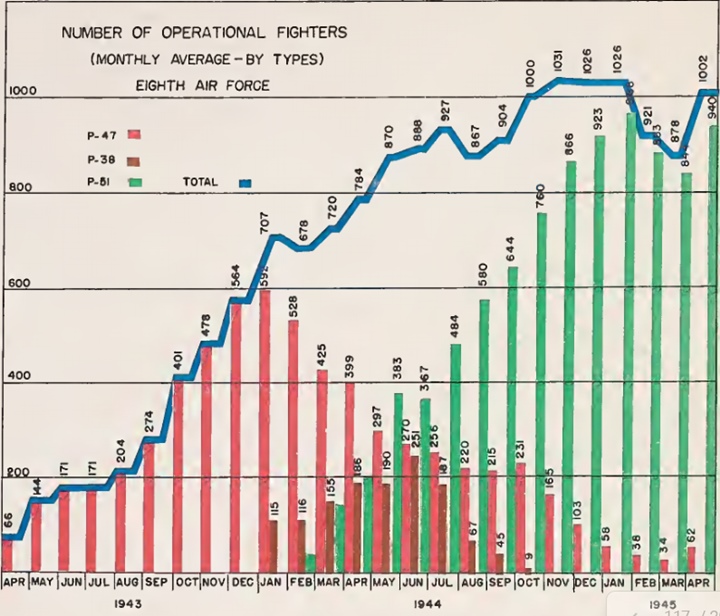
Graph 1: The Eighth Air Force
was deployed to the United Kingdom in 1942 to begin the strategic
bombing of occupied Europe and Germany with B-17s and B-24s.
Starting in April 1943, this graph shows the number and types of
fighters that were assigned to provide high altitude escort for the
bombers. While the Eighth Air Force bombers began operations in mid-1942, this graph shows they had no fighter escort. Air Force
bomber doctrine at the start of the war assumed that heavily armed
bombers in tight formations could defend themselves. Very quickly,
this was found to be untrue and P-47s were rushed to England as quickly
as the aircraft could be built and the pilots trained. Between
April and December 1943, P-47s had the sole responsibility of
providing fighter escort for the bombers.
Source: Eighth Air Force: Tactical Development, August 1942
- May 1945.
As the number of P-47s went down in the 8th
Air Force, the P-47s were moved to the 9th Air Force which provided
tactical air support for the U.S. Army in Europe. New P-47s coming
off the Evansville assembly lines later in the war were destined for Europe
to serve with the 9th Air Force.

Graph 2: In April 1943
approximately 50 of the 66 P-47s were lost in combat and in accidents.
While the loses continued at that rate through October 1943, the amount
of operational P-47s continued to climb because Evansville was helping
to supply aircraft faster than they were lost.
Source: Eighth Air Force: Tactical Development, August 1942
- May 1945.
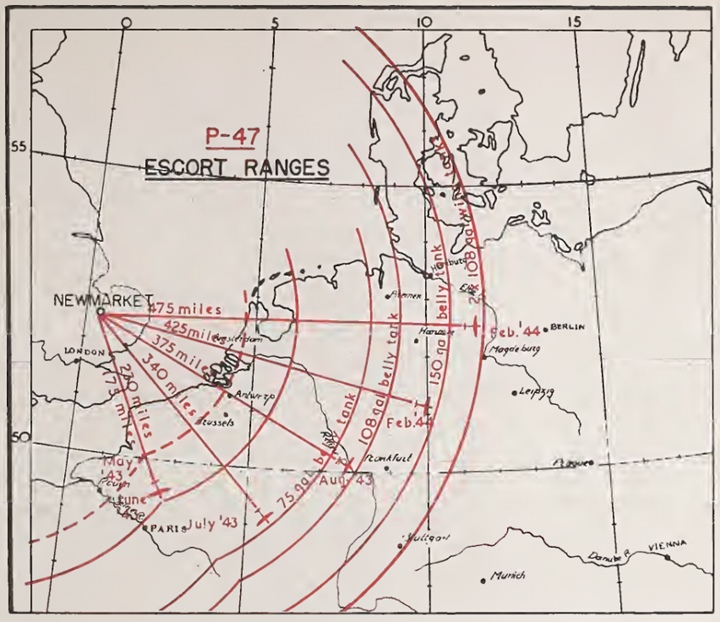
Map 1:
This shows that with the addition of larger and more fuel drop tanks, the
P-47s methodically extended their range into Europe.
Source: Eighth Air Force: Tactical Development, August 1942
- May 1945.
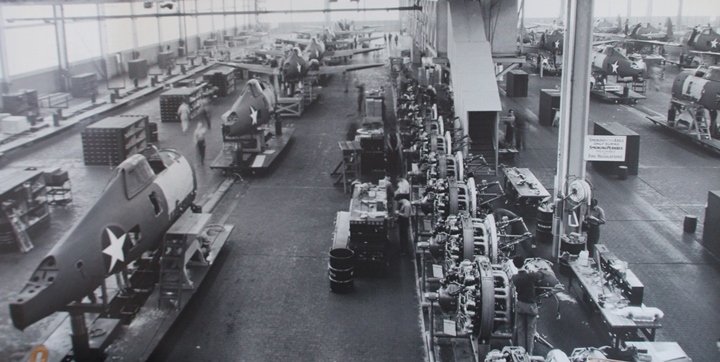
There were four parallel assembly lines in
the Evansville plant for the manufacture of P-47 Thunderbolt.
Pratt & Whitney R-2800 radial aircraft engines can be seen ready for
installation next to the assembly line on the left of the photo.


The P-47's fuselage was built around a
General Electric turbo supercharger system. This resulted in the
P-47 having a rather portly fuselage. This entire P-47 turbo
supercharger system is on display at the National Museum of World War II
Aviation in Colorado Springs, CO. As can be seen, the system runs
the entire length of the aircraft. Author's photo.
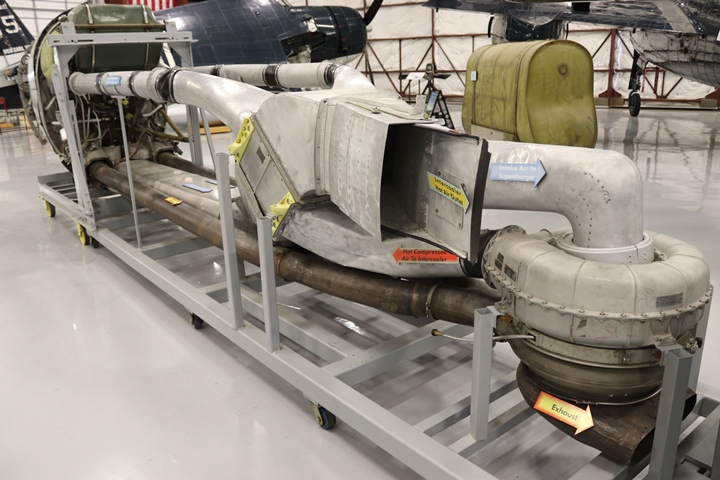
The two steel pipes that run along the
bottom of the aircraft are the exhaust lines from the engine. The
hot exhaust gases with a temperature of 1,500 degrees Fahrenheit drive
the rotor section of the turbo supercharger up to 25,000 rpm. The
top two pipes that run the length of the aircraft comprise the intake
air for the engine. The rectangular shaped pipe located between
the exhaust pipes is the intake air that is routed through the
intercooler and then into the supercharger where it is compressed.
The compressed air is then routed back through the intercooler where it
is cooled by the intake air and then routed back to the engine through
the top two pipes. Note that the intake air line is so much larger
in volume than the return lines to the engine. This shows how much
the air was compressed in operation. The exhaust gases exited the
rear bottom of the aircraft as shown above. Author's photo.
It was this GE turbo supercharger system that
provided enough air for the P-47 to operate at high altitudes to combat
enemy fighters. This was especially important in the European
Theater of Operations, as early in the war the P-47 was tasked with
escorting B-17s and B-24s to their bombing targets.

This enlargement shows the hot air outlet
from the intercooler and the hot compressed pipe back to the
intercooler. Author's photo.
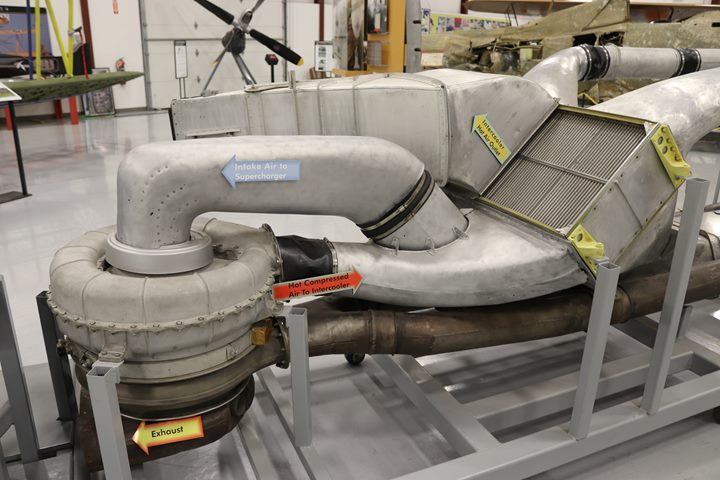
The P-47 came equipped with a Harrison Radiator
Division of General Motors intercooler. The museum has removed the
shroud on the port side of the system to show where the intercooler is
located. Intake air was split just before the intercooler.
Half went to the compressor while the other half was used as cooling air
in the intercooler. Also shown is the exhaust outlet. The pipe with the
blue arrow is cool intake air going into the compressor section of the
turbo supercharger. The red arrow indicates the hot compressed air
going to the intercooler where it is cooled by intake air. Author's photo.
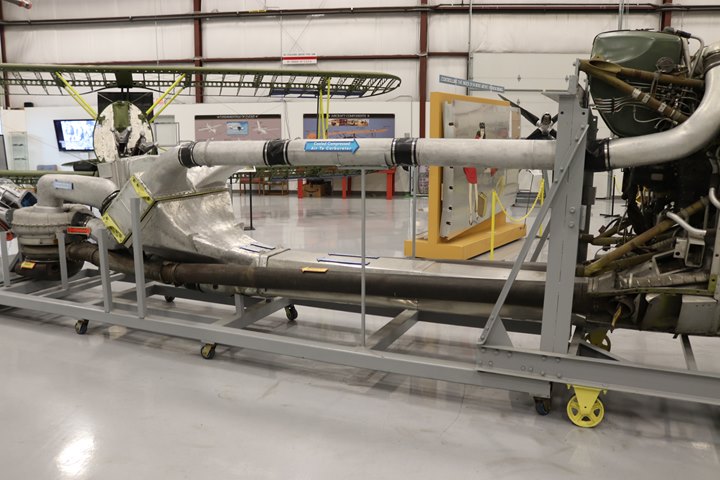
The blue arrow on the return line
indicates it is carrying cool compressed air to the carburetor of the
aircraft. The dark steel pipe at the bottom carries hot exhaust gas
to power the supercharger and the large rectangular sheet metal duct
carries intake air. Author's photo.
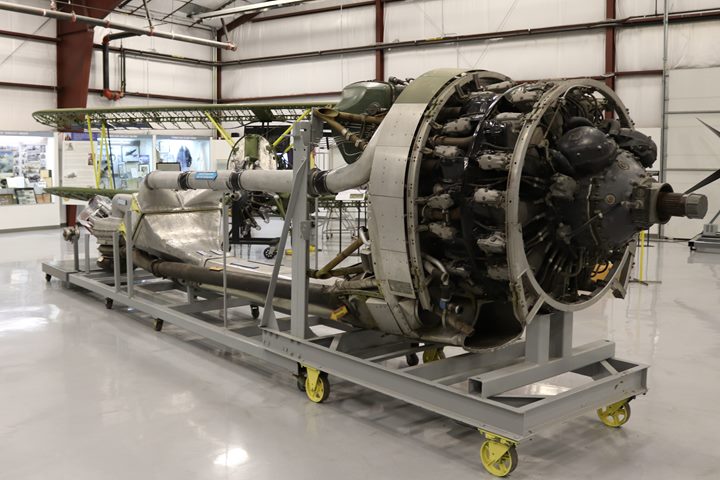
Intake air for the engine enters through the
large opening at the bottom the engine. Author's photo.
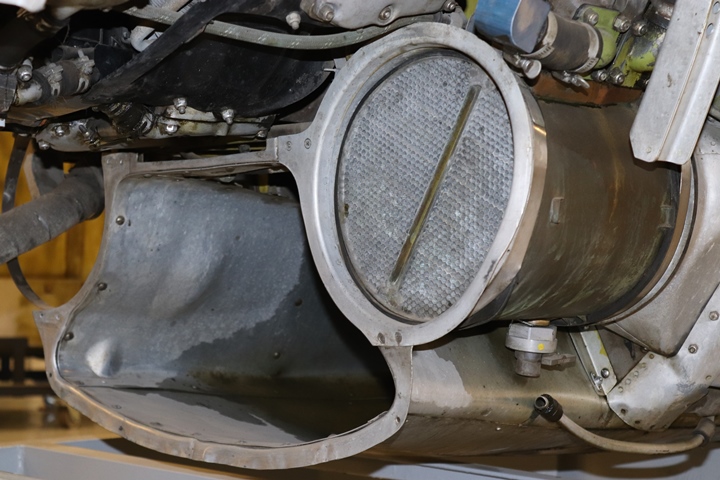
This close-up shows the air intake opening.
Author's photo.
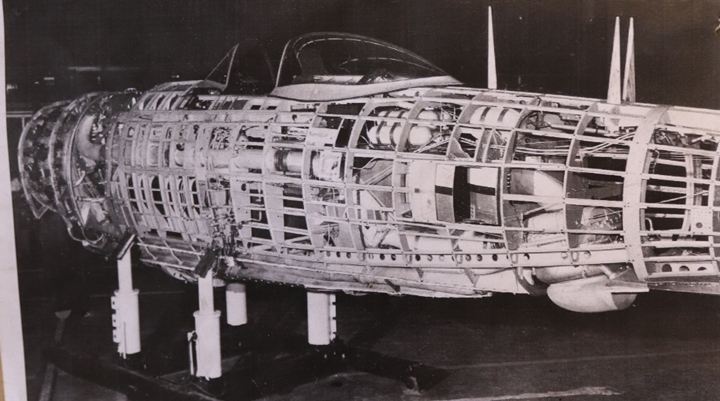
This factory photo shows the tubing,
ducting, and supercharger within the framework of the aircraft.
Evansville workers built the frame around the turbo supercharger system.
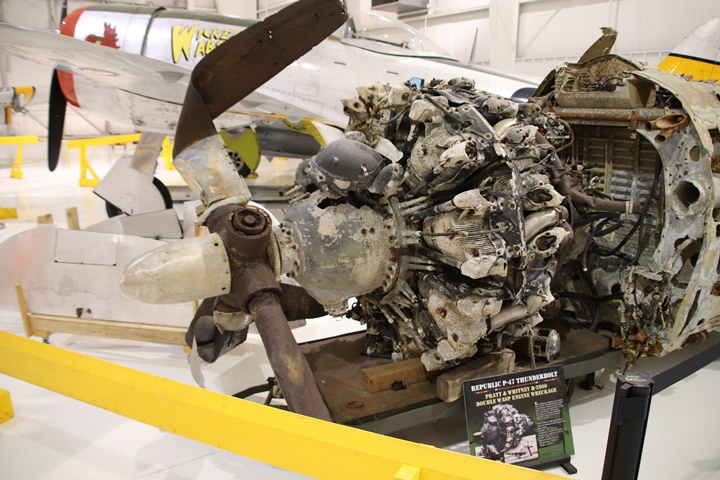
This section of the engine and cockpit area
was salvaged from a wreck in the Pacific. It is on display at the
Tennessee Museum of Aviation in Sevierville, TN. This photo shows
what remains of the propeller and engine. Author's photo.
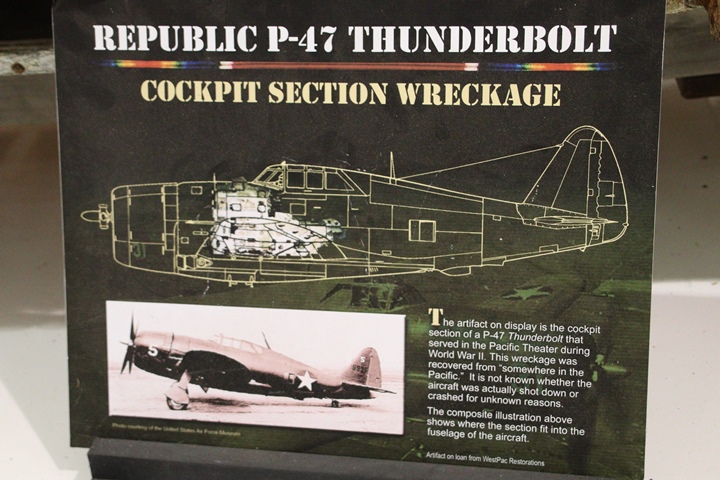
Author's photo.
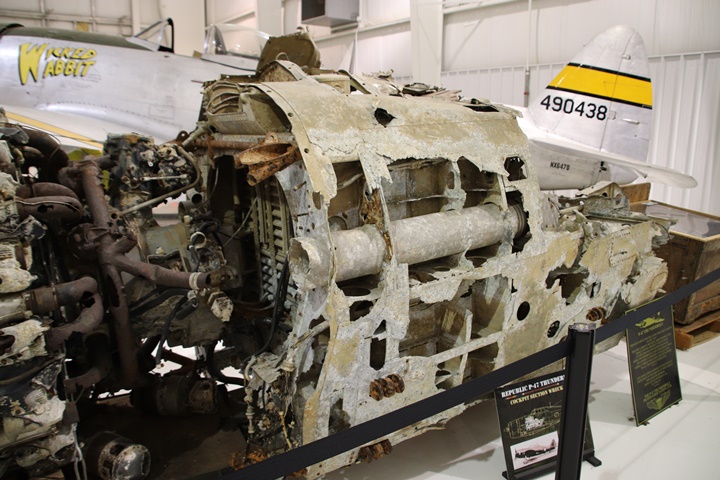
The remains of the compressed intake air
line is visible on the display. Author's photo.

This view is looking into the remains of the
cockpit area. Author's photo.

Sections of both compressed air
intake lines are visible in this view. Also, a rudder pedal is
laying on the floor of the cockpit. Author's photo.

This P-47 fuselage framework is also on
display at the National Museum of World War II Aircraft. The
supercharger system is not installed in this display. Author's
photo.
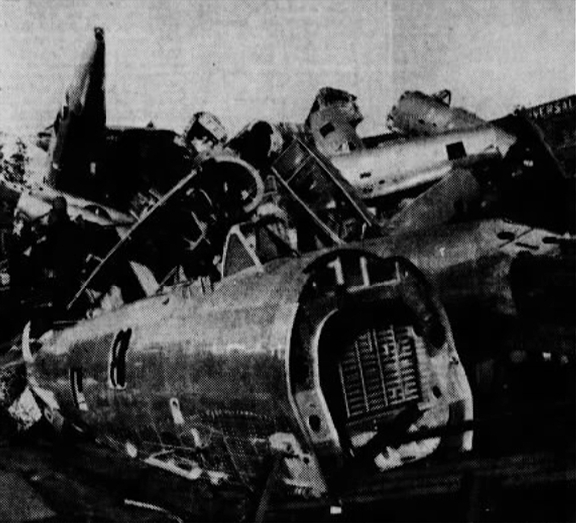
The end of the line for many P-47 fuselages
and wings at $125 per set after the end of the war. While the cost
of the P-47 fuselages and wings was $40,000, the scrap cost paid for aluminum at the time was $25 per ton. The P-47 fuselages and wings
without the engine, propeller, guns, and landing gear was five tons.
When production shut down there were approximately 100 Thunderbolts on
the Evansville assembly line in various stages of completion.
There were also all of the stamped components and subassemblies that
needed to be removed from the factory. It took over 30 truckloads
per day for over a month to remove all of the scrap from the plant.
A sad end for all of the Thunderbolt components that so many persons worked
hard to build.
Presidential Visit:
The importance of the Republic Evansville
P-49 assembly plant was emphasized when President Franklin D. Roosevelt
visited the factory on April 27, 1943.


Surviving Evansville-built P-47s:
There are nine P-47s shown below. With the one at the Evansville
Wartime Museum, there are ten known surviving Evansville-built P-47s.

This Evansville-built P-47D is on display at
the National Air and Space Museum Steven F. Udvar-Hazy Center near
Chantilly, VA. Author's photo added 9-20-2022.
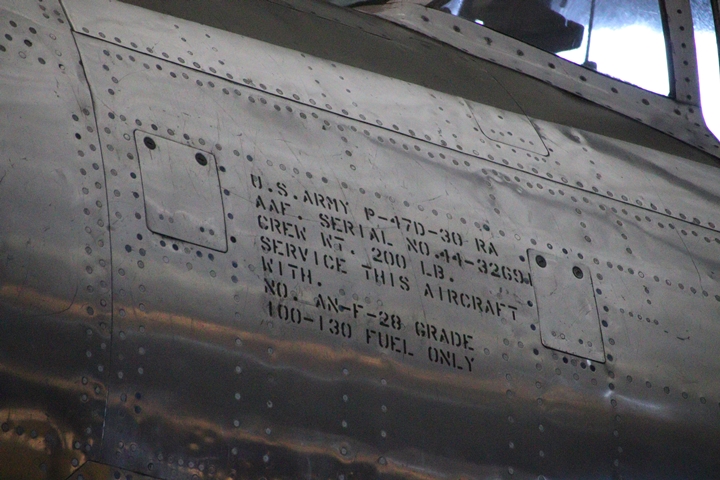
P-47D serial number 44-32691 served as an aerial gunner trainer after
being sent to Godman Field, KY in 1944. Author's photo added
9-20-2022.
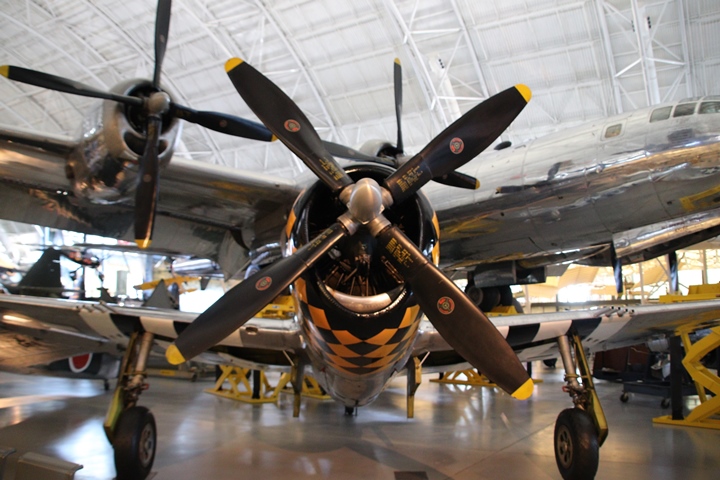
The information placard for this aircraft does state that it was built
in Evansville, IN. Hopefully, this will be noted by the 1.9
million annual visitors who visit the museum. Author's photo
added 9-20-2022.
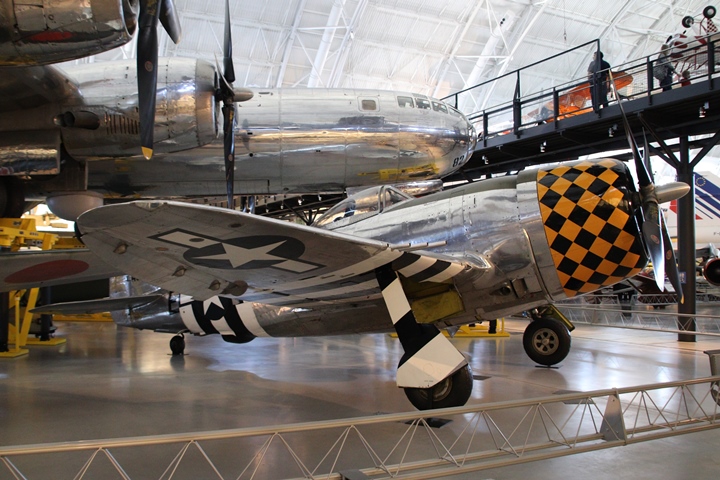
Author's photo added 9-20-2022.
The National Air and Space Museum Steven F. Udvar-Hazy Center is one of
the two largest and most visited aviation museums in the United States.
In 2019, it had 1.9 million visitors. The other of the two largest
and most visited aviation museums is the National Museum of the United
States Air Force in Riverside, OH. It has two Evansville-built
P-47s on display. This museum has an annual attendance of over
800,000 visitors. While the Evansville plant only produced 39.8%
of the P-47s, 100% of the P-47s on display at the two largest aviation
museums in the United States were built in Evansville. How cool is
this?
The two Evansville-built P-47s
on display at the National Museum of the United States Air Force shown
below have incorrect serial numbers on them.
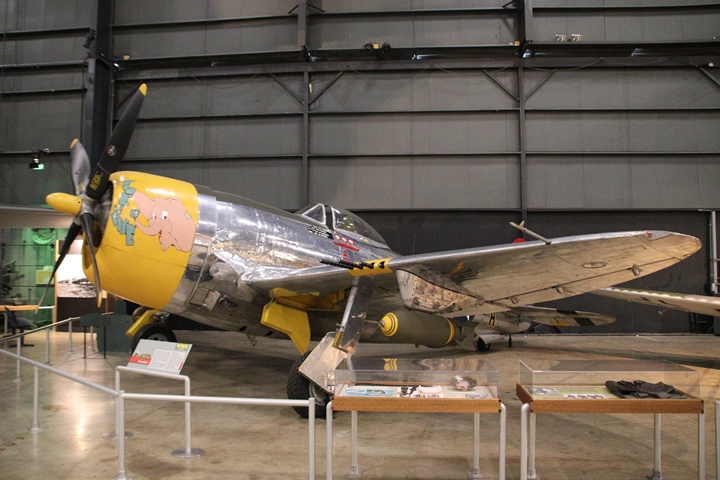
This P-47D with a bubble canopy shows
it as serial number 44-33287. This is the serial number of the
aircraft the museum has chosen to represent for its display.
According to its website, this is actually 45-49167. Author's
photo.

The serial number 44-33827 represents the
aircraft flown by Colonel Joseph Laughlin of the 362nd Fighter Group in
Italy during 1945. While the serial number portrayed on the side
of the aircraft is incorrect, it is still an Evansville-built P-47.
Author's photo.
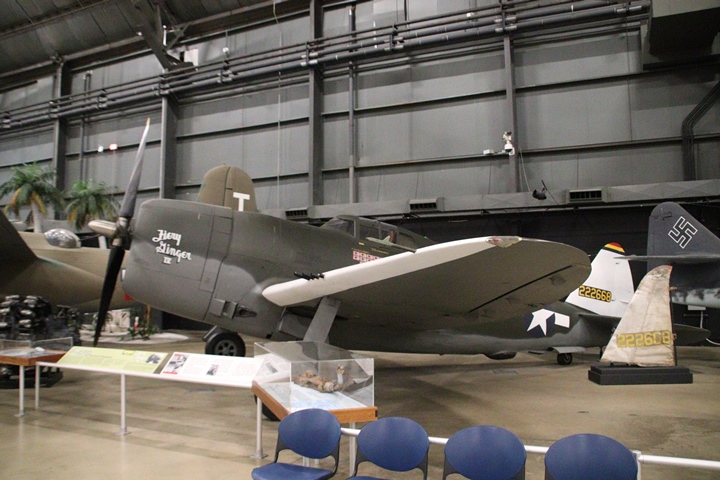
The second Evansville-built P-47D at the
National Museum of the United States Air Force with a razor back canopy
is shown as serial number 42-22668. This P-47 is actually
Evansville-built 42-23278. It is the oldest known surviving P-47
built in Evansville. Author's photo.

This P-47 has an Army Air Corps serial
number. All of the other P-47s shown on this page have Army Air
Force serial numbers. This is actually 42-23278. Author's
photo.

Two Evansville-built P-47s that are
still flying are "Hun Hunter XVI" and "Wicked Wabbit." "Hun Hunter
XVI" is serial number 44-90460 and "Wicked Wabbit" is serial number
44-90438. This photo was taken on a Saturday morning, June 14,
2014, at the Evansville, IN airport as the two aircraft were being prepared by
their pilot-owners to fly in the Evansville River Front Airshow.
The two P-47s are sitting just a mile north of where they were built in
1945. Author's photo.
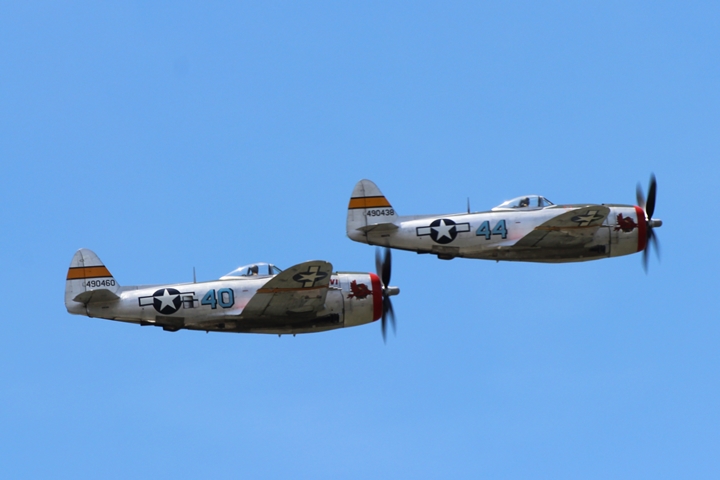
The two P-47s in formation during the 2014
Evansville Airshow. Author's photo.

When not flying at airshows, "Hun Hunter
XVI" and "Wicked Wabbit" can be seen on display at the Tennessee Museum
of Aviation in Sevierville, TN. The following photos were taken in
May 2022. Author's photo.
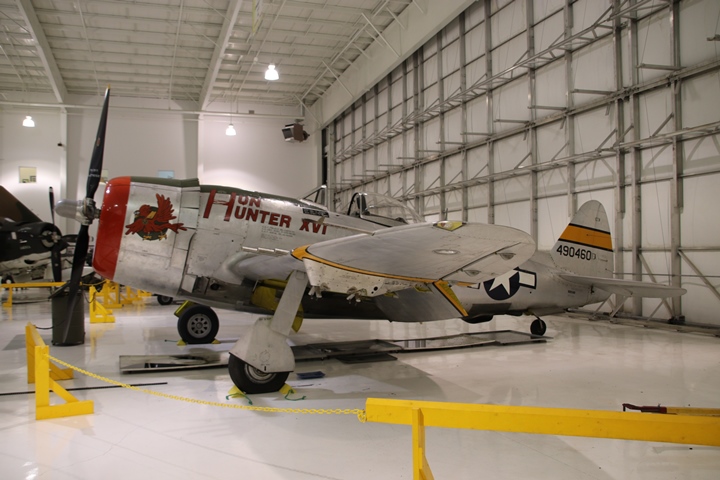
Author's photo.

Author's photo.
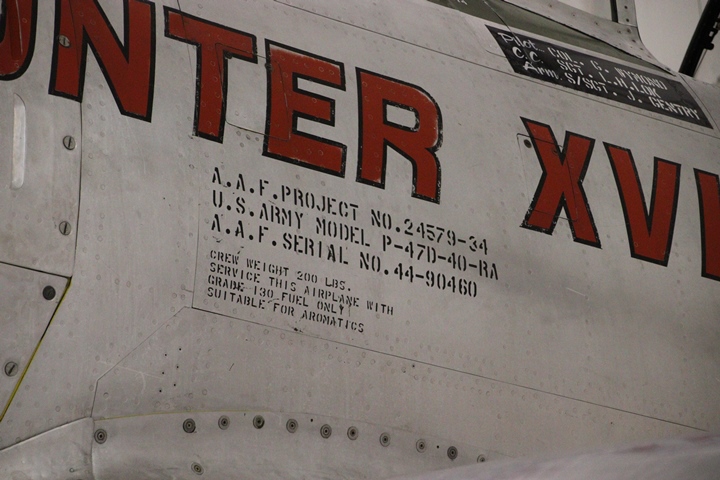
Author's photo.
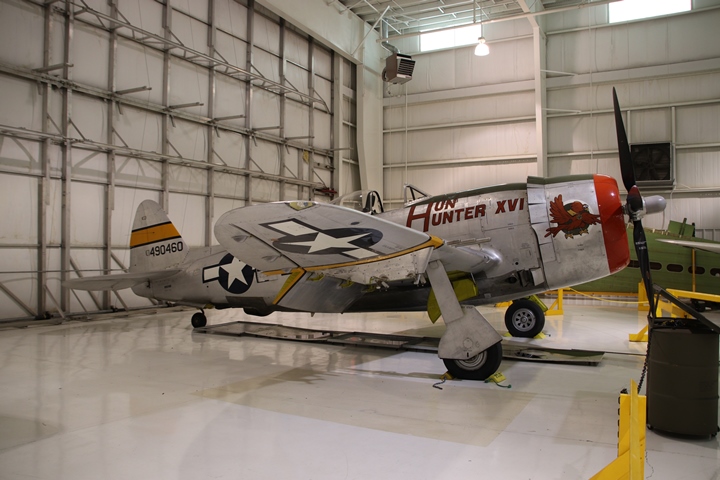
Author's photo.
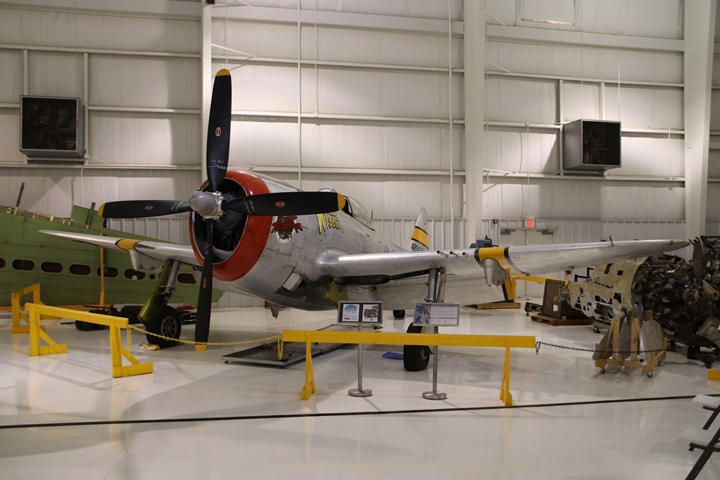
Author's photo.

Author's photo.
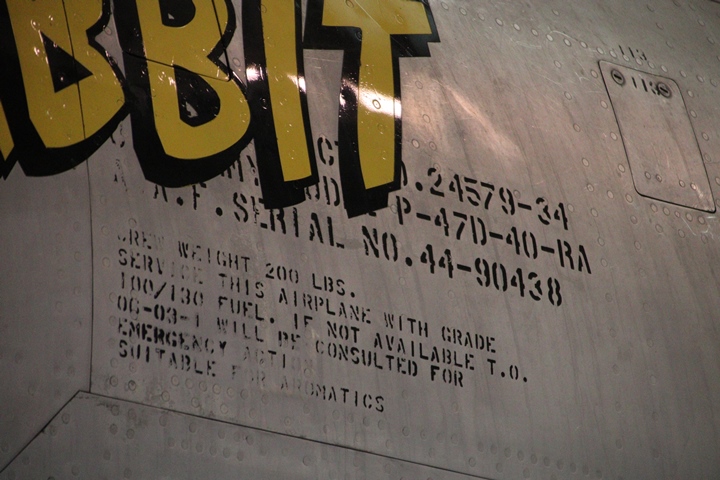
Author's photo.

The Kalamazoo Air Zoo Aerospace & Science
Museum has Evansville-built 45-49181 on display. Author's photo.
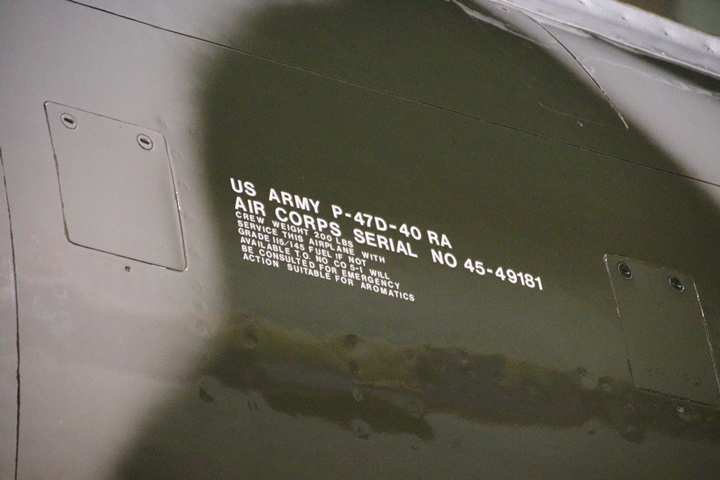
Author's photo.
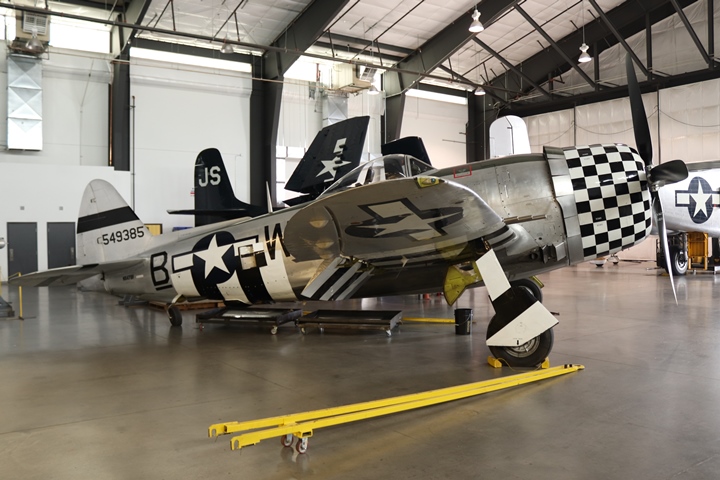
The National Museum of World War II Aviation
in Colorado Springs, CO has Evansville-built 45-49385 on display.
Author's photo.
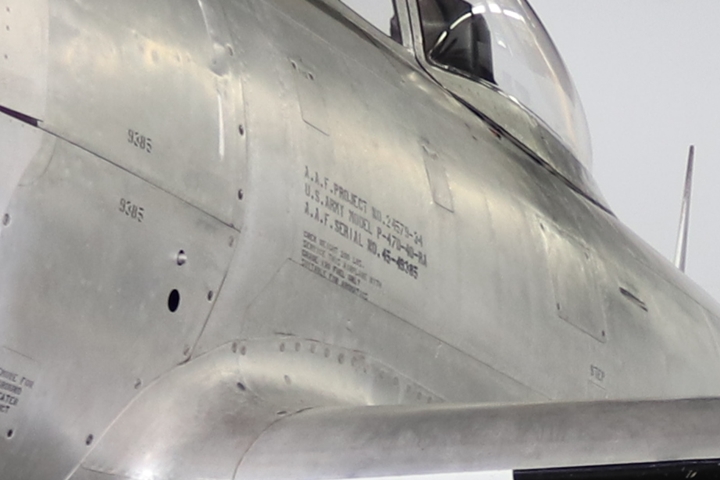
Author's photo.
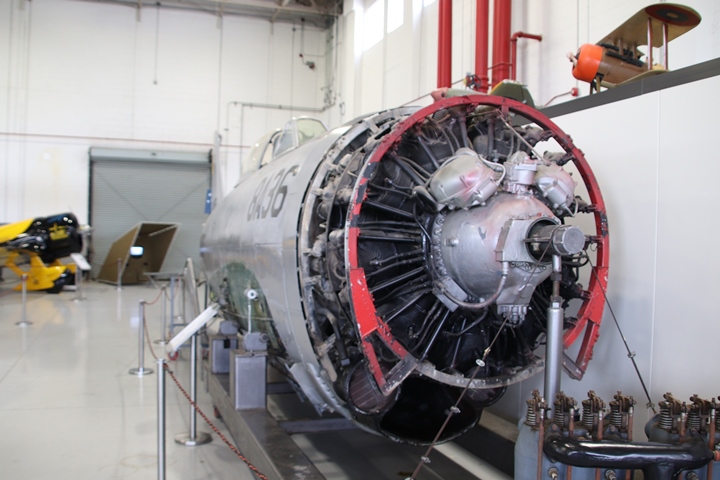
This is the fuselage and engine of
Evansville-built P-47D, serial number 44-32814 and is on display at
Fantasy of Flight in Polk City, FL. It is awaiting restoration.
Author's photo.

With no cowling over the engine, the large
air intake for the aircraft that leads back to the turbo supercharger
system can be seen. The aircraft's oil coolers are on either side of it. Author's photo.
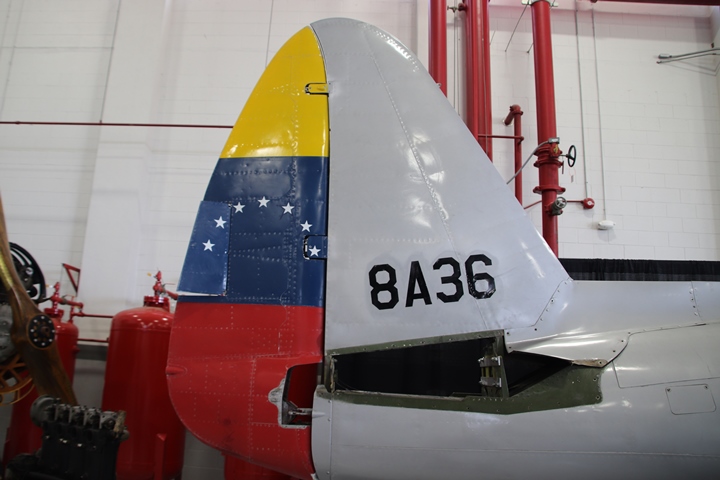
The vertical stabilizer and rudder are still
attached. Previously, this aircraft served with the Peruvian Air
Force and still has its identification on the vertical stabilizer.
Author's photo.
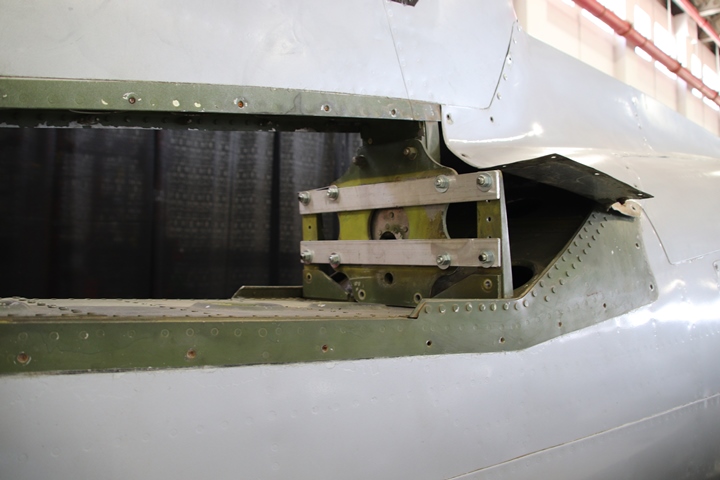
This slot is where the horizontal stabilizer
attaches to the aircraft. A few of the innumerable rivets used in
the aircraft's construction are visible. Author's photo.
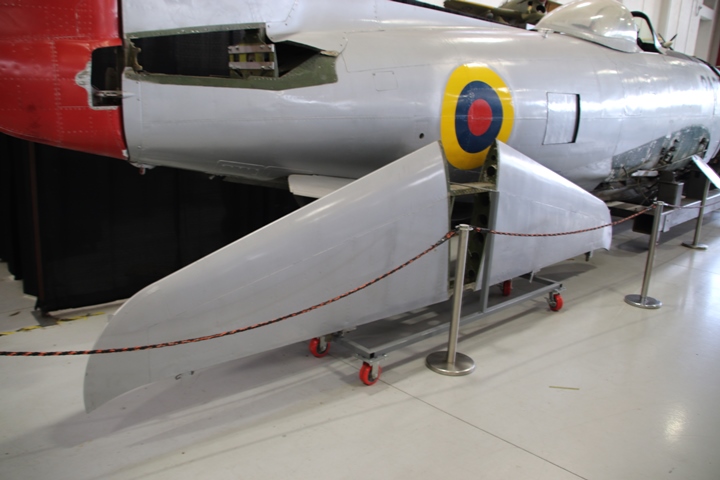
The horizontal stabilizers, minus the
elevators, are on display in front of the aircraft. The horizontal
stabilizers were manufactured by Hoosier Cardinal of Evansville, IN.
The Peruvian Air Force three-colored roundel is still on the fuselage.
Author's photo.
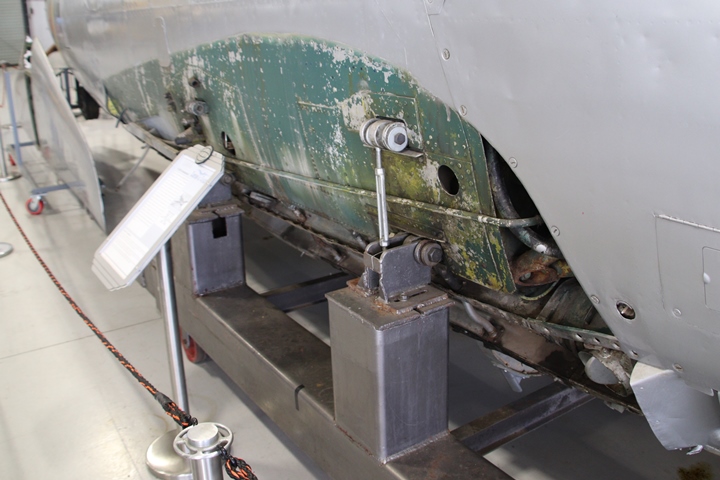
The four wing attachment points have been
used to secure the fuselage to the shipping frame. Author's photo.
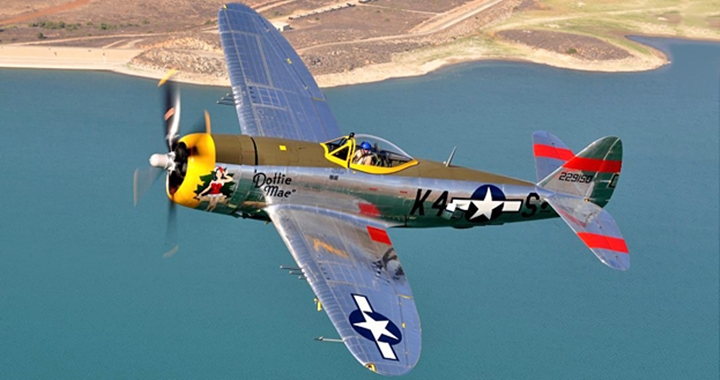
How cool is this? Evansville-built P-47D 42-29150 "Dottie Mae" was
the last USAAF aircraft lost in Europe on May 8, 1945. This was
after the war when the aircraft was on a special demonstration flight
over the Ebensee, Austria Concentration Camp. The pilot misjudged
his altitude while flying low over nearby Traunsee Lake and the aircraft
hit the water and sank. The pilot escaped from the P-47 and was
rescued. The P-47 rested at the bottom of the lake until it was
recovered in April 2005 and then restored to flying condition in the
United States.
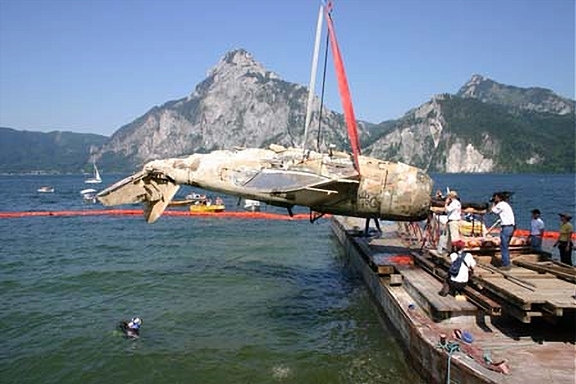
The Plant:

This 1944 photo was taken from a field
across US-41 from the plant. The factory was north of the
Evansville airport and not part of it. Finished P-47s had to be
towed across a road to get to the airport for test flights.

This aerial view shows the Republic
modification center at the Evansville airport.
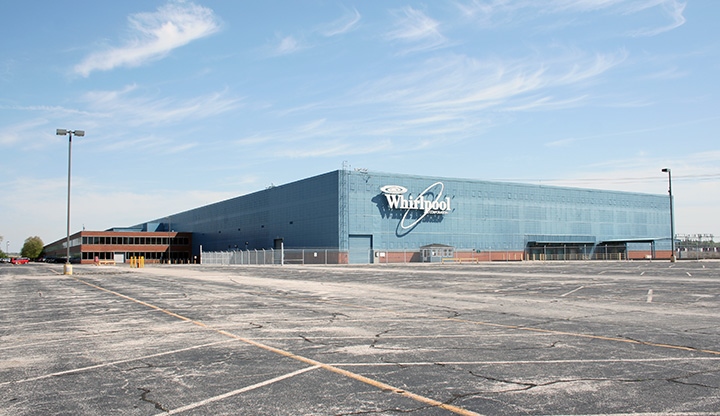
After World War Two, the plant was purchased
by International Harvester. It later sold the facility to
Whirlpool for refrigerator production. This photo was taken in
2014 not long after Whirlpool moved the plant production to Mexico.
The "Whirlpool" sign was still on the building and there was only a
couple of companies using small parts of the plant. A return visit
in 2022 found that the plant was being occupied by multiple companies.
At this end of the factory, a steel company now occupies the space and
parking lot, which is now fenced to about the location of where this
photo was taken. There are now also overhead doors cut into
the office area. Author's photo.
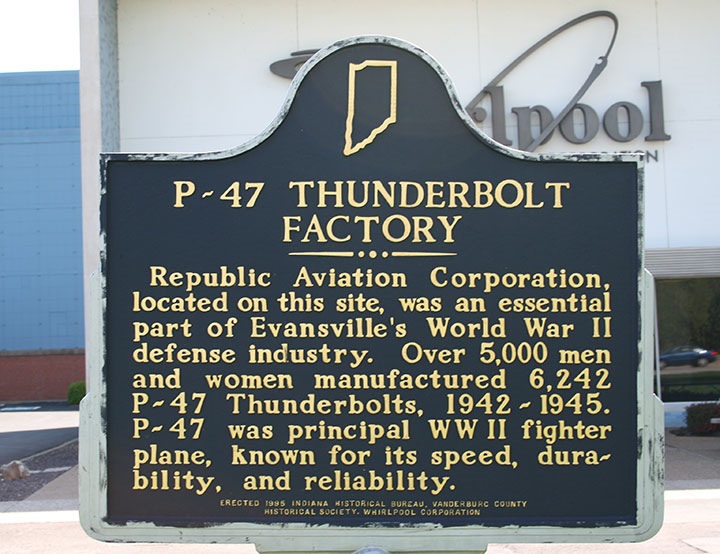
Since it was built 80 years ago, the factory
has gone through several owners and has now been subdivided and
repurposed for use by multiple companies. Still, a historical
marker stands in front of the plant recognizing that 6,242 P-47
Thunderbolts that helped win World War Two were built here. Author's
photo.
|































































